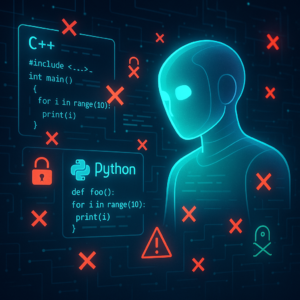Unlocking the Future of AI: Your Guide to Language Model Watermarking

Unlocking the Future of AI: Your Guide to Language Model Watermarking
In today’s rapidly evolving landscape of artificial intelligence, language models are the rock stars driving everything from chatbots to content creation. But as these AI wonders become more prevalent in our digital lives, there’s a growing buzz around a crucial question: how do we protect intellectual property and maintain content integrity? Enter the concept of language model watermarking—the unsung hero in AI accountability and authenticity!
Watermarking language models might sound as mysterious as deciphering the Enigma code, but it’s a fascinating solution designed to trace the origins of AI-generated content. Think of it as digitally tagging content with invisible ink, seen only by the tech-savvy eyes of a detective AI. In this blog, we break down groundbreaking research on how language models themselves are used to create these watermarks, promising a new era of AI transparency and protection.
What Is Language Model Watermarking?
Imagine writing a secret note on a lemon with invisible ink. You see nothing until you hold the paper over a flame, revealing the hidden message. Language model watermarking operates on a similar principle—embedding invisible markers within AI-generated text. These markers are sneakily injected and only detectable by specialized systems, verifying the origin and protecting the content from misuse.
Why Does It Matter?
With AI models generating everything from your morning news to your business report, the importance of watermarking can’t be overstated. As AI scales up in areas like content creation and automation, issues of copyright, content authenticity, and responsible usage are thrust into the spotlight. Watermarking acts as the guardians of content, ensuring legal and ethical practices are adhered to in an increasingly AI-dominated world.
The Dynamic Duo: A Novel Watermarking Scheme
The research introduces an innovative approach that sounds straight out of a sci-fi movie script. It involves a multi-model setup with three distinct roles: prompting, marking, and detecting.
- Prompting Model: Think of this as the Director. It generates specific instructions or “watermarking recipes.”
- Marking Model: This is your Star Actor, executing those instructions and infusing the AI-generated content with watermarks.
- Detecting Model: Our Sleuth in the setup, it verifies whether what’s produced is authentically watermarked.
This approach is as dynamic as it gets—tailoring watermarks to fit the content like a bespoke suit. Unlike static methods that slap the same watermark across all content like a brand on cattle, this dynamic system adjusts based on context, making it robust and adaptable.
A Dive into the Techniques
Text-Based Watermarking
Some methods embed watermarks by altering how tokens (the building blocks of text) are selected and generated. Imagine having a secret pattern that only appears when you lock certain keys in a song. This pattern can be detectable by specific algorithms yet remains hidden from casual onlookers.
Model-Based Watermarking
Other approaches incorporate watermarks into the model’s architecture itself, like embedding a fingerprint within the framework of a building. These techniques are potent in guarding against unauthorized tampering with models and maintaining the integrity of the AI’s performance.
A Prompting Twist
The prompted-based method involves using triggered prompts to watermark outputs—a bit like sprinkling fairy dust that you can call forth anytime, without direct control over the model’s innards.
Real-World Applications
Imagine a scenario where an AI-generated article becomes viral. Without watermarking, traceability back to its original AI model could be as challenging as looking for a needle in a digital haystack. This research paves the way for practical applications, from tracking the authenticity of news articles to safeguarding intellectual property in creative industries.
Experimenting with ChatGPT and Mistral
In a series of experiments, researchers used prominent AI models, ChatGPT and Mistral, to test their watermarking prowess. Here’s a breakdown of the drama in the lab:
-
ChatGPT as a Leading Actor: With its natural flair for understanding prompts, ChatGPT proved adept in seamlessly introducing watermarks. It flexed its versatility by maintaining high text quality, achieving a stellar detection accuracy of 95%—a solid testament to the framework’s success.
-
Enter Mistral: With its own strengths, it delivered commendable detection accuracy of 88.79%, showcasing the framework’s adaptability and potential for widespread application across different model architectures.
But, like any good story, there’s a twist! When the researchers tried to train a single detecting model to cover both language models’ watermarked outputs, the accuracy dwindled to 86%. This highlights a core insight: sometimes, it’s best to have a tailored detective for each unique case in our AI whodunit.
Key Takeaways
-
Invisible Ink for AI: Language model watermarking plays a pivotal role in ensuring content authenticity and protecting AI-generated text.
-
Dynamic Watermarking: This approach uses a trio of models to dynamically tailor watermarks, making the process robust, adaptable, and context-sensitive.
-
Real-World Impact: The potential applications of this research are profound, from establishing content provenance to enforcing copyright protection in AI-generated outputs.
-
Best Fit Detection: Training a bespoke detection model for each watermark model proved more effective than a catch-all solution, emphasizing the need for personalized detection in maintaining high accuracy.
As the curtain falls on our exploration, it’s clear that watermarking is essential for the ethical and legal use of AI in content creation. This research not only showcases a promising path forward but also invites AI enthusiasts, developers, and watchdogs to imagine a future where AI’s stamp in our digital world is as authentic and indelible as conceivable. So, as you navigate the world of AI, remember the power hiding beneath the text. From subtle tweaks to monumental breakthroughs, language model watermarking is set to make waves—one invisible mark at a time.
If you are looking to improve your prompting skills and haven’t already, check out our free Advanced Prompt Engineering course.
This blog post is based on the research article “Watermarking Language Models through Language Models” by Authors: Xin Zhong, Agnibh Dasgupta, Abdullah Tanvir. You can find the original article here.




